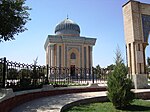Khidr Bey
Khidr Beg خضر بك | |
|---|---|
| Title | Khidr Beg Çelebi |
| Personal | |
| Born | 810 A.H. = 1407 A.D. |
| Died | Some reports place his death in 860 A.H. = 1456 A.D., but 863 A.H. = 1459 A.D. is more likely Constantinople (nowadays Istanbul) |
| Religion | Islam |
| Era | Islamic Golden Age |
| Region | |
| Denomination | Sunni |
| Jurisprudence | Hanafi |
| Creed | Maturidi |
| Main interest(s) | Aqidah, Kalam (Islamic theology), Logic, Fiqh (Islamic jurisprudence), Arabic prosody, Literature, Tafsir |
| Notable work(s) | Jawahir al-'Aqa'id, better known as: al-Qasida al-Nuniyya ("Ode Rhyming in the Letter Nun [N]") |
| Muslim leader | |
Influenced | |
Khidr Bey or Khidr Beg (Turkish: Hızır Çelebi (Hızır Bey); [Note 1] Arabic: خضر بك) was an Ottoman Hanafi-Maturidi scholar and poet of the 9th/15th century, and the first kadi (qadi) of Istanbul. The unique source for his biography is the Arabic original of al-Shaqa'iq al-Nu'maniyya by Tash-Kopru-Zade.[1]
Biography
[edit]He was born in Sivrihisar, where his father, Jalal al-Din, was kadi — though the fact that the latter was, also. He completed his studies in Bursa under the famous scholar Molla Yegan, whose daughter he married, and is then said to have returned to Sivrihisar as a teacher. He acquired such a reputation for learning that he was appointed to the madrasa of Mehmed I in Bursa with an increase in stipend, and certain of his pupils here were subsequently to become scholars of great eminence. Next he taught at the madrasa of Bayezid I in Bursa, again with an increased stipend, and in addition was appointed kadi of İnegöl. From here he moved to the newest of the two madrasas in the Üç Şerefeli Mosque in Edirne, and thence to Yanbolu (in present-day Bulgaria) as kadi.
His three sons, Ya'kub Pasha, Mufti Ahmad Pasha and Sinan Pasha, were also notable scholars, the latter being the author of the famous Tadarru'dt.
Death
[edit]After the conquest of Istanbul in 857/1453, he was appointed its first kadi, in which post he remained until his death in 863/1458-9. He is buried in the Zeyrek quarter of Istanbul, where he also built the mosque later attributed to a certain Hadjdji Kadin.
He was buried next to the tomb of Abu Ayyub al-Ansari (Eyüp Cemetery), the companion of Muhammad who died during the First Arab Siege of Constantinople (674–678 CE).
Works
[edit]Although Khidr Beg is reputed to have introduced the versified chronogram into Ottoman literature, very few of his Turkish poems have survived and his reputation rests on three poems in Arabic.
The first, a didactic qasida in the basit metre on the creed, is known as the Nuniyya and has been the subject of several commentaries, most notably that by his pupil al-Khayali.
Another qasida, also a Nuniyya, also called Jawahir al-'Aqa'id (Arabic: جواهر العقائد), dealing with the creed, but in the wafir metre, is usually known as 'Ujalat layla aw laylatayn (Arabic: عجالة ليلة أو ليلتين), is paid special attention in Ottoman period by writing many commentaries.
Finally, there is a Mustazad, in a Persian variety of the hazadj metre, which was greatly admired and attracted imitations for over a century. Bursall Mehmed Tahir mentions a translation into Persian of the Mafdli' which he made at the request of Sultan Mehmed II the Conqueror, the work in question probably being the Matali' al-Anwar, on logic, by Siraj al-Din al-Urmawi (d. 1283).
See also
[edit]- Abu Hanifa
- Abu Mansur al-Maturidi
- Shams al-Din al-Fanari
- Sa'd al-Din al-Taftazani
- Al-Sharif al-Jurjani
- Akmal al-Din al-Babarti
- Ibn Kemal
- Ebussuud Efendi
- Muhammad Zahid al-Kawthari
- Muhammed Hamdi Yazır
- Abd al-Ghani al-Nabulsi
- Shah Waliullah Dehlawi
- Abd al-Hayy al-Lucknawi
- List of Ash'aris and Maturidis
- List of Muslim theologians
Notes
[edit]- ^ The name Hıdırbey is originally Khidr Bey, Lord Khidr.
References
[edit]- ^ H.A.R. Gibb (1979–1980). The Encyclopaedia of Islam. Brill Publishers. pp. 4–5.
External links
[edit]- Cawahir al-'Akaid of Hızır Bey
- Hızır Çelebi (Hızır Bey) (in Turkish)
- Hızır Çelebi (Hızır Bey) (in Turkish)
| |||||||||||||||||||||||||||||||||||||||||||||||||||||||||||||||||||||||||||||||||||||||||||||||||||||||||||||||||||||||||||||||||||||||||||||||||||||||||||||||||||||||||||||||||||||||||||||||||||||||||||||||||||||||||||||||||||||||||||||||||||||||||||||||||||||||||||||||||||||||||||||||||||||||||||||||||||||||||||||||||||||||||||||||||||||||||||||||||||||||||||||||||||||||||||||||||||||||||||||||||||||||||||||||||||||||||||||||||||||||||||||||||||||||||||||||||||||||||||||||||||||||||||||||||||||||||||||||||||||||||||||||||||||||||||||||||||||||||||||||||||||||||||||||||||||||||||||||||||||||||||||||||||||||||||||||||||||||||||||||||||||||||||||||||||||||||||||||||||||||||||||||||||||||||||||||||||||||||||||||||||||||||||||||||||||||||||||||||||||||||||||||||||||||||||||||||||||||||||||||||||||||||||||||||||||||||||||||||||||||||||||||||||||||||||||||||||||||||||||||||||||||||||||||||||||||||||||||||||
- Hanafis
- Maturidis
- 15th-century Muslim theologians
- Muslims from the Ottoman Empire
- Philosophers from the Ottoman Empire
- Turkish logicians
- Turkish Sunni Muslim scholars of Islam
- Turkish legal scholars
- Turkish jurists
- Turkish poets
- People from Sivrihisar
- Sunni imams
- Sunni fiqh scholars
- Sunni Muslim scholars of Islam
- Sharia judges
- Jurists from the Ottoman Empire
- Mehmed the Conqueror
- 1407 births
- 1456 deaths
- 1458 deaths
- 1459 deaths

